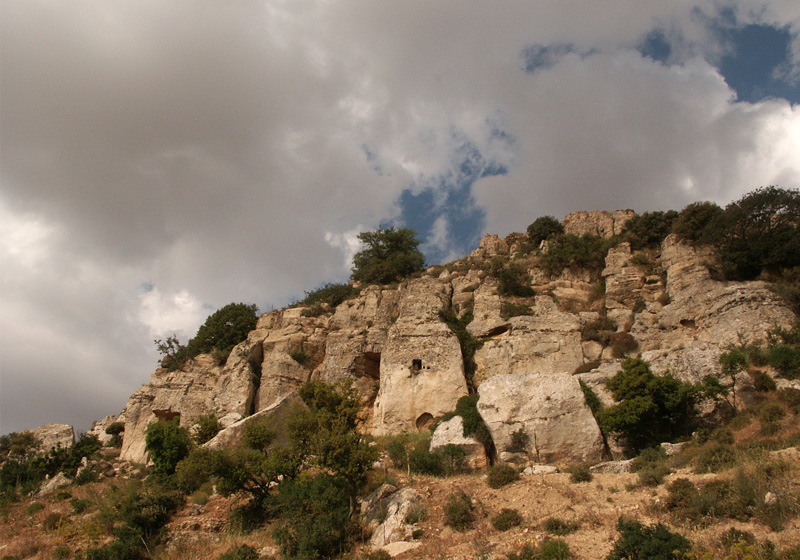Hanging Hermitage
There are seasons to paint landscapes. One of the best is late autumn when Jordan’s air gets clearer, adding more focus, sharpness and color intensity to the subject.
In the slopes below, stood some oak trees and a few big cubes of rock that once tumbled from the massive cliff in the process of creating the Great Rift Valley. Between the rounded masses of oak, in dark green, and the angular masses of rock, in golden ochre, patches of soil were trapped as a binding skin. The total composition was one of tranquility and stillness, like a vast arrangement of still life, crisp, arranged at the foot of the cliff and gradually disappearing into the wide-angle horizon of Jordan Valley. Adding to this visual symphony was a man with a mule, plowing the fragmented patches of soil. For the painting of this landscape, nothing would have been better than this man adding lines of blood-red by scarring the surface of soil, opening, line after line, the moist inner layer. The plow was like a knife scarring living skin, as in some eternal ritual of a strange ethnic event. With every new line that the plow added, the brush followed, laden in maroon pigment and water; for the painting of this landscape had to cope with a moving composition at it appears from Muallaga.

Before arriving to Muallaga “the hanging place”, you descend the goat-track that passes by a big pine tree and brings you at the foot of the cliff. From below, one small window facing southwest can be seen and next to it to the west a bigger opening is tucked away where the massive rocks meet. Here, a difficult, dangerous and intelligent climbing way must be found.
With careful inspection, you spot stepping gaps, alternating, right- left- right- left. These small niches, orange-size, are placed for crawling vertically up. The problem, that heightens the excitement, and adds to the risk, is that some of these stepping holes are heavily eroded or polished by use, making it difficult to have a safe grip.
Assuming you found Muallaga, and managed to climb the 4-5 meter rock-ladder, you then arrive to a kind of a balcony. The edge of this balcony has a small water reservoir that the hermit(s) must have planned for. Looking on the face of the rock, above, you can spot a channel 15cm x 15cm, chiseled to direct rain water in.
The balcony extends inward creating an irregular space like a living room of about 2.5 x 3 meters. From the end of this space, towards the valley, you descend a few steps to find a “bedroom” or rather a bed-space of elongated shape, which can provide a place for two. This room ends magnetically with a small window about 60 x 50cm. From this window, the distant view of Jerusalem appears as if looking through a zoom-lens.
Towards the mountain, the most important room can be found –a chapel. This is the sacred spiritual space reserved for prayers. After almost crawling into this space, due to the accumulation of soil, you find a relatively squarish room with vaulted ceiling.
In many locations of this monolithic structure, one can find niches and shelves; some still retain a little of the black soot of lighting fire.
Muallaga can be dated to the Byzantine 5th century AD, when hermits and solitary worship became a fad. Pottery fragments below also indicate use of space during later Islamic periods.
Muallaga is a beautiful secret place, it might not be known even to archaeologists at the Department of Antiquities.
This destination is to be kept a secret. The place is difficult to climb to, and somewhat dangerous. It is also such a small and fragile spot that is better kept away from visitors; if one finds it by chance then the visit is legitimately earned. For those curious to locate this spot, pay attention to context and surrounding environment. For those familiar with Jordan’s rock layers and vegetation habitats, locating the place can become easier. Look for the few hints in the text, good luck.